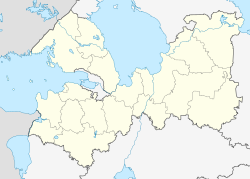Gatchina
| city
Gatchina
Gattchina
|
||||||||||||||||||||||||||||||||||||||||||||
|
||||||||||||||||||||||||||||||||||||||||||||
|
||||||||||||||||||||||||||||||||||||||||||||
| List of cities in Russia | ||||||||||||||||||||||||||||||||||||||||||||
Gatchina ( Russian Га́тчина ) is a city in the Russian Oblast Leningrad and is 45 kilometers south of Saint Petersburg on the European route and the railway line to Pskov . The population is 92,937 (as of October 14, 2010). The city has achieved fame above all for its castle, which was at times the tsar's residence.
history
Gatchina was first mentioned in 1499; Originally the place belonged to Novgorod , with its submission in 1478 Gatchina also came to the Grand Duchy of Moscow . Like the whole of Ingermanland , Gatchina belonged to Sweden from 1583 to 1595 and from 1617 to 1721 ( Peace of Nystad ) . Peter the Great , Emperor of the New Russian Empire , gave Gatchina to his sister Natalja. In 1765, Empress Catherine gave the Great Gatchina to her favorite, Count Grigori Grigoryevich Orlow , who had the Gatchina Castle built here. The last Russian emperor , Nicholas II , spent his youth here; after his abdication in 1917 he was temporarily placed under house arrest in Gatchina.
In 1858, Gatchina was connected to the capital via the Petersburg-Warsaw Railway . The entire line to Warsaw was opened in 1862.
In 1923 the city was renamed Trozk (Троцк) after the revolutionary Leon Trotsky . After Trotsky fell out of favor, it was renamed Krasnogwardeisk (Красногвардейск) in 1929 , before the city was given its old name again in 1944.
Shortly after the start of the German-Soviet War on June 22, 1941, Gatchina was occupied by Wehrmacht troops. In the course of the Leningrad-Novgorod Operation , the Red Army recaptured the place in early 1944.
Population development
| year | Residents |
|---|---|
| 1897 | 14,824 |
| 1939 | 38.201 |
| 1959 | 36,725 |
| 1970 | 63.292 |
| 1979 | 75,153 |
| 1989 | 79.714 |
| 2002 | 88,420 |
| 2010 | 92,937 |
Note: census data
sons and daughters of the town
- Paul Friedrich von Benckendorff (1784–1841), Governor of the Estonian Governorate from 1833 to 1841
- Andrei Stackenschneider (1802–1865), architect
- Pyotr Tschichachev (1812–1890), explorer
- Michail Chigorin (1850–1908), chess player
- Fyodor Wassiljew (1850–1873), painter
- Michail Ippolitow-Iwanow (1859–1935), composer and conductor
- Michail von Doliwo-Dobrowolski (1862–1919), engineer
- Modest Ivanov (1875–1942), first Soviet admiral
- Jan Zachwatowicz (1900–1983), Polish architect
- Anastassija Russkich (* 1983), badminton player
- Jelisaveta Demirova (* 1987), sprinter
- Irina Chlebko (* 1990), badminton player
- Daniil Linchevsky (* 1990), chess player
- Svetlana Kolesnitschenko (* 1993), synchronized swimmer, 2016 Olympic champion
- Alexander Bublik (* 1997), tennis player
- Yevgeny Tyurnev (born 1997), tennis player
Town twinning
Gatchina is twin town of
Individual evidence
- ↑ a b Itogi Vserossijskoj perepisi naselenija 2010 goda. Tom 1. Čislennostʹ i razmeščenie naselenija (Results of the All-Russian Census 2010. Volume 1. Number and distribution of the population). Tables 5 , pp. 12-209; 11 , pp. 312–979 (download from the website of the Federal Service for State Statistics of the Russian Federation)
- ↑ Gerd Koenen : The great songs: Lenin - Stalin - Mao Tsetung. Leadership cults and hero myths of the 20th century . Eichborn, Frankfurt am Main, 2nd edition 1991. ISBN 3-8218-1143-9 . P. 64.




